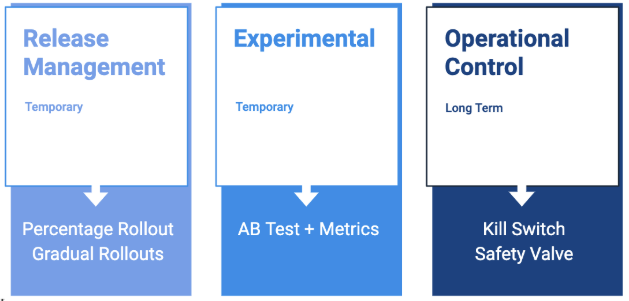Manage the Feature Flag Lifecycle
Overview
As you scale utilization, it becomes increasingly important to have a strategy for how to best clean up feature flags. This should be a consideration from the very first feature flag you create.
When creating new feature flags, there are a variety of reasons for placing a change or new feature behind a feature flag.
Feature flag types
The three main types of flags to consider are the following:

-
Release Management feature flags:
- Example: "I want to expose a feature flag to a subset of my traffic that meet a certain criterion (location, age, plan type)"
- Example: "I want to safely do a progressive or gradual rollout for a potentially high impact feature, expose to 10% at first then gradually increase".
-
Experimental feature flags:
- Example: "I want to learn if the new version of an existing feature, or an entirely new feature, has a positive or negative impact on my business metrics".
-
Operational Control feature flags:
- Example: "If this feature were to have an issue, it could potentially impact revenue or conversions, I want the ability to quickly revert back to the previous steady-state".
Retire a feature flag
Now that you have feature flags in production, what are the indicators you might establish for when to retire a flag?
- Feature flags that have not been modified within the past 30 days are eligible for retirement.
- Feature flags that have received no traffic in the last 7 days are eligible for retirement.
- Metrics show that you the feature flag has proven the feature should be rolled out to everyone or removed from code = eligible for retirement.
To surface the feature flags that fall into the first two criteria, within the Environments tab in your Split dashboard, you have the option to filter by;
- Active feature flags
- Killed feature flags
- Feature flags that have received traffic in the last 7 days
- Feature flags that have received no traffic in the last 7 days
- Feature flags that have seen no traffic at all
- Feature flags that have been modified in the last 7 days
- Feature flags that have not been modified in the last 30 days

Before removing a feature flag from code, ensure that everyone in the population is receiving the same intended treatment, essentially rolled out to 100%.
Integrate cleanup tasks into your project process
- As part of the project within the existing Jira ticket (or the feature tracking tool of your choice), you can create a subtask for retiring the feature flag with a specific due date or time period.
- There could also be a subtask within the ticket that states a mandatory feature flag review/kill date.
- Schedule a recurring cadence for the team to review and retire eligible feature flags.
- Adopt a process to add a retire tag on the feature flag once the rollout or experiment is complete.